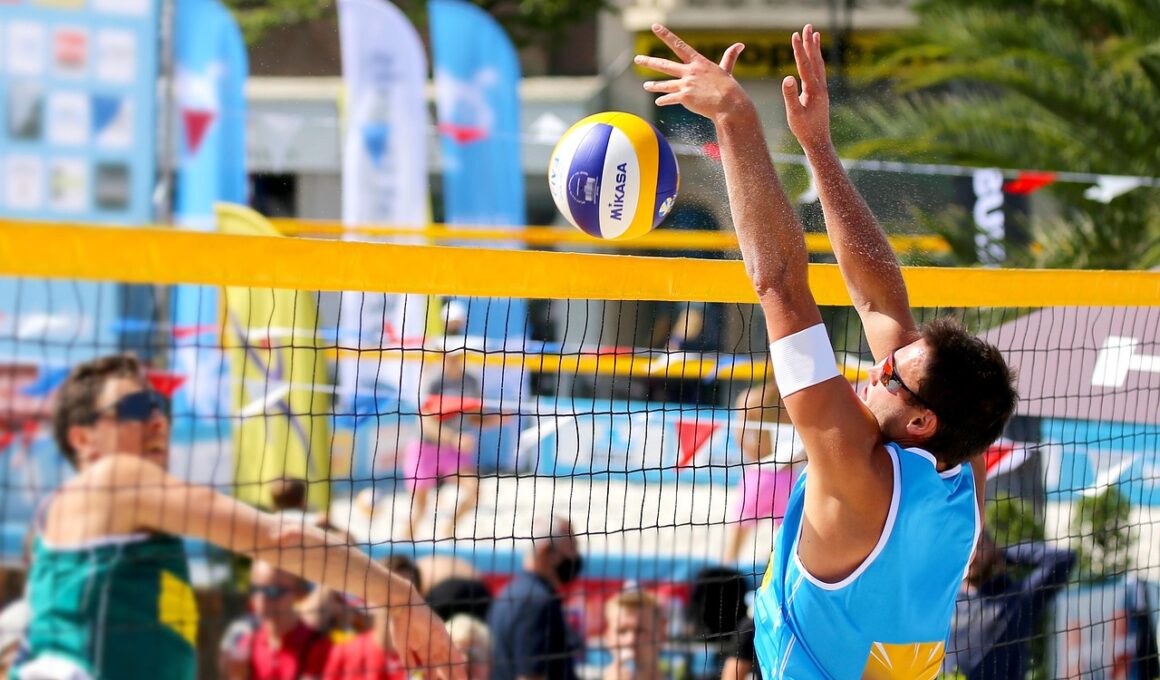Benefits of Plyometric Exercises for Volleyball Players’ Jumping Ability
Plyometric exercises are essential for enhancing the jumping ability of volleyball players. These explosive movements help to develop power and improve athletic performance. When athletes perform plyometrics, their muscles undergo rapid stretching and contracting, which enhances their overall strength and speed. Through consistent training, volleyball players can experience a significant increase in their jump height. Moreover, incorporating plyometric exercises into a training regimen can improve agility and coordination. Athletes become more adept at reacting to the fast-paced nature of the game. The benefits of plyometrics extend beyond just vertical jump height; they also improve a player’s ability to change directions quickly during gameplay. Additionally, these exercises aid in injury prevention by reinforcing muscles and joints. A well-structured plyometric training program can also enhance a player’s mental toughness, as they push through discomfort. Many volleyball coaches recommend these exercises for athletes at varying skill levels. By emphasizing proper landing techniques and body control, players can maximize their gains without putting themselves at risk. Incorporating a range of drills, such as box jumps and depth jumps, can keep training sessions new and engaging.
Plyometric exercises contribute significantly to explosive strength development, which is vital for volleyball players aiming to improve their performance. Strong leg muscles are crucial for achieving higher jumps, and plyometrics excel at that. These workouts train the neuromuscular system to respond quicker, allowing for faster and more powerful jumps. Strengthening the fast-twitch muscle fibers is particularly important, as they are primarily responsible for delivering explosive energy during athletic movements. Plyometric routines often include various exercises such as squat jumps, tuck jumps, and hurdle hops, catering specifically to vertical jump training. Implementing these exercises can lead to measurable improvements in jump height within a relatively short timeframe. Also, a structured plyometric training regime can enhance muscle endurance, which is equally important as volleyball matches are often lengthy. Properly executed, plyometric drills not only increase strength but also improve overall conditioning. As players perform these exercises, they refine coordination, balancing the body, and timing. This seamless integration of movements is crucial for executing skillful plays during a game. Ultimately, volleyball players focusing on plyometrics are investing in their athletic future, with better jump ability translating to enhanced gameplay.
The Role of Technique in Plyometric Training
Technique plays a pivotal role in the effectiveness of plyometric exercises for volleyball players. Ensuring proper form during each drill is critical to achieving maximum benefit and minimizing injury. Athletes must focus on landing softly and maintaining a balanced posture throughout each movement. This not only enhances performance but also enforces safety during training sessions. Coaches often emphasize the importance of quality over quantity. For example, performing a fewer number of plyometric routines with excellent form is far more beneficial than numerous repetitions executed poorly. Incorporating strength training alongside plyometrics can amplify the positive results. Developing a solid foundation of strength allows athletes to handle more intense plyometric work later on. Players should gradually progress to more challenging exercises as they build confidence and proficiency. Specific focus should be placed on engaging the core muscles, as they stabilize the body during explosive movements. This improvement in body control translates into performance improvements on the court. Regular evaluations of technique help players identify areas needing attention. Ultimately, mastering technique ensures players maximize the benefits from plyometric exercises and improve their in-game performance effectively.
Nutrition also plays a vital role in maximizing the benefits of plyometric training for volleyball athletes. Adequate energy intake is necessary to fuel the intense workouts required for effective plyometric routines. A well-balanced diet consisting of carbohydrates, proteins, and healthy fats helps support muscle recovery and growth. Athletes need to ensure proper hydration to maintain optimal performance levels; dehydration can negatively impact energy and power output during plyometric exercises. Consuming a nutrient-dense meal or snack before training can provide the necessary energy for strenuous workouts, allowing players to push through intense exercise. Post-workout nutrition is equally important; refueling the body with protein and carbohydrates aids in recovery and muscle repair. Many players benefit from consulting with sports nutritionists to develop tailored meal plans that meet their specific needs. Timing meals around training sessions can also enhance performance and recovery. Maintaining a consistent nutrition plan can lead to improved overall athletic performance, enhancing the effectiveness of plyometric training. Ultimately, focusing on nutrition allows athletes to sustain their energy, recover faster, and elevate their game on the volleyball court.
Plyometrics and Injury Prevention
Plyometric exercises, when executed correctly, can significantly reduce the risk of injuries commonly seen in volleyball players. A crucial aspect of plyometric training involves optimizing the muscle’s ability to absorb forces. Improved landing mechanics help prevent injuries related to the knees, ankles, and joints. By training the body to absorb shock effectively, athletes can decrease the likelihood of encountering injuries during gameplay. This is particularly relevant to volleyball, where jumping and sudden direction changes are frequent. Strengthening the stabilizing muscles surrounding joints also aids in injury prevention. Solidified muscles provide better support for the entire kinetic chain, contributing to a safer athletic performance. Incorporating a warm-up routine that combines dynamic stretching and low-intensity plyometrics can prepare the body for intensive workouts. Coaches often instruct players to perform cool-down exercises, focusing on flexibility to promote recovery. These aspects together contribute to an athlete’s longevity in their sport. Furthermore, a well-rounded training program that includes both strength and plyometric workouts can cultivate resilience in the face of physical demands. Ultimately, integrating injury prevention strategies into plyometric training optimizes player safety and performance.
Incorporating plyometric exercises into a volleyball player’s training routine is critical for maximizing jumping ability and overall performance. These exercises not only enhance vertical leap but also improve muscular strength, power, and reaction times essential for the sport. Coaches and trainers should emphasize a holistic approach, integrating plyometric training with other forms of conditioning and skill development. Athletes can experience enhanced game performance through combining jump training with sport-specific drills. The intensity and volume of plyometric exercises may need to be adjusted based on each player’s fitness level and goals. Periodic assessments can help customize training plans effectively. Moreover, introducing variations of plyometric drills can keep training sessions engaging and challenging. Regularly changing the exercises helps prevent plateaus in performance, providing continual improvement. Examples of plyometric exercises that can be quickly adapted for volleyball players include lateral bounds, single-leg jumps, and medicine ball throws. Ultimately, integrating these variations into the training routine can contribute to a well-rounded athletic development. With the right guidance and structured plans, volleyball players can unlock their full potential by incorporating plyometric exercises into their regimen.
Conclusion: Embracing Plyometric Training
Embracing plyometric training can profoundly impact volleyball players’ performance and overall athleticism. Players targeting increased jump height and agility will benefit significantly from these dynamic workouts. As athletes invest time and effort into plyometrics, they may gradually notice marked improvements in their game. Furthermore, the supportive community of coaches and fellow athletes can help sustain motivation and dedication to this form of training. Consistency, coupled with proper technique and nutrition, ensures that all the advantages of plyometric exercises are realized over time. With dedicated practice and the right approach, volleyball players can develop explosive power and enhanced body awareness critical for success in the sport. Establishing a strong foundation through plyometric training not only influences performance but also results in added confidence on the court. Players who embrace these exercises as part of their training regimen will find themselves better equipped to handle the physical demands of competition. Ultimately, plyometrics foster both athletic growth and enjoyment of the sport by enhancing performance while reducing injury risk. As volleyball continues to evolve, plyometric training remains an integral part of developing well-rounded athletes.


